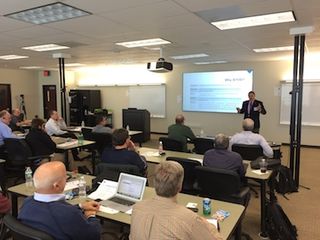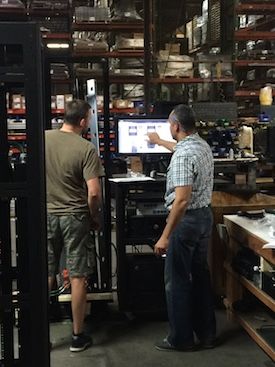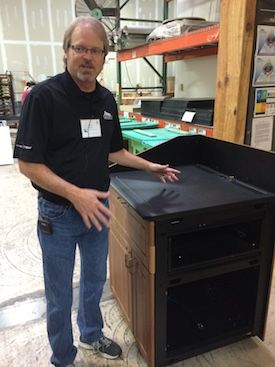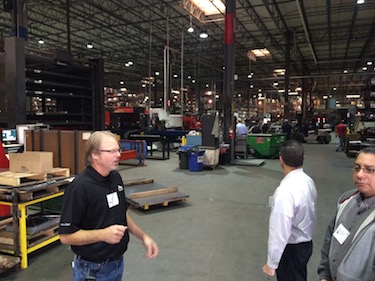- When you think of Middle Atlantic, the first thing that comes to mind is probably equipment racks. And for good reason: the company has established a sparkling reputation for making some of the most capable and versatile racks in the industry. But like any forward-thinking organization, Middle Atlantic is broadening its horizons for the future.
“We are infrastructure,” said Dan Tarkoff, vice president of customer experience at Middle Atlantic. “We’re not the system; we’re the thing that supports the system. We look at foundational products that every job needs, and whether it’s a rack, or whether it’s power, or whether it’s furniture, or floor boxes, and now with C2G, cables and connectivity products—so think of all the things people need that are foundational things.”
I recently paid a visit to Middle Atlantic’s headquarters and factory in Fairfield, NJ, to see how the company builds these foundations, as well as to sit in on some classes the company was holding for InfoComm’s AV Month.

Joe Cornwall, technology evangelist at Legrand, teaching a class to the 25 in-room participants, as well as 100 registered webinar guests.
The morning began with the one of the industry’s most ebullient pedagogues, Joe Cornwall, rustling the 25 attendees (as well as the 100 or so others watching remotely via webinar) out of their morning torpor with an invigorating lecture on the subject of “Digital Video at Length.” Striding fervently about the room, Cornwall taught us the finer points of video distribution, covering the difference between coax, optical fiber, twisted pair category, HDBaseT, and SDI cabling. After a short break, Lisa Zorn, product manager at Middle Atlantic, gave a brief presentation on unconventional ways of concealing hardware in racks. As Zorn explained, the smaller form factors of newer equipment is making non-traditional mounting methods, such as attaching components in the “no-man’s land” behind the rack rail, a popular alternative to occupying unnecessary amounts of rack space.
We then broke up in to several groups for our tour of the factory, a 415,000-square-foot facility that employs some 350 workers and some of the most state-of-the-art robotic machinery. Mark Tracy, Middle Atlantic’s VP of strategic business and market development, started our tour out in the engineering and project management department. Located directly adjacent to the factory floor, the product managers and engineers collaborate here early on in the concept phase for new products, and can then easily take the concepts to manufacturing to develop prototypes.

Mark Tracy, Middle Atlantic's VP of strategic business and market development, leading our tour group into the manufacturing floor.
Putting on our safety glasses, we made our way into the fabrication floor. Here, stacks of steel sheets arrive cut to size, where they are taken to the proper machines to be cut and punched. Middle Atlantic employs a combination of turret presses and lasers to cut the steel. The whole fabrication floor is a model of efficiency: for simpler cuts and hole punches, the faster turret presses are used, with the slower laser machines reserved for more complex shapes and patterns; the forklifts that carry the materials around the floor are all equipped with iPads, featuring virtual factory maps and messaging to alert operators where materials are needed; and all of the scrap metal, which is minimized though careful design, is collected to be recycled.
Next, we headed over to the forming area, where the company utilizes both manual and automatic presses to shape metal into racks, boxes, and other equipment infrastructure devices. The robotic, automatic press was mesmerizing to watch: it swiftly grabs a freshly cut sheet of steel and slides it delicately into the press, where it is folded twice to form the edge of a door, then is briskly withdrawn and twirled 90 degrees, so the process can be repeated on the other sides. The forming process also involves welding, which is carried out by robots as well.
After forming, the components move to the finishing area, where they receive their powder coating. Hanging from a wire, the panels travel through a spraying station, where electrically charged powder is applied, and then though a baking station, where the finish is set. As Tracy explained, powder coating is preferable to wet spray painting, as it is more durable, environmentally friendly, and less susceptible to corrosion. After the parts leave the baking station, they make a trip around the ceiling of the warehouse to cool, like stiff shirts on a clothesline.
Moving on from the finishing area, we got a glimpse of the process behind one of the company’s most popular offerings, the online configurator. In the midst of the stock room, where an inventory of some 4,000 racks are maintained at all times—because, as Tracy says, “racks are often the last thing thought of and the first thing needed on jobs”— custom orders come in from the company’s online custom ordering tool, and workers assemble the components. According to Tarkoff, the configurator helps integrators take a fresh look at the possibilities available with racks. “Sometimes people just get used to designing the way they do, and they don’t really get a chance to see new things,” he said. “So the configuration tool is a place where they can go and see things that maybe they hadn’t seen before, and see options that maybe they weren’t aware of. And it’s actually helping them understand other options available, to design projects maybe a little differently.”

Factory workers custom configuring a rack based on an order from the company's popular online configurator tool.
The tour also gave us a look at the shipping department, which the company claims is capable of delivering products to 90 percent of the U.S. within 48 hours, as well as the woodshop, where the company’s extensive line of furniture is manufactured using high-tech processes like thermal lamination apply a wide variety of finishes to the products to meet almost any desired aesthetic.
After the conclusion of our tour, we reconvened in the training room for the day’s final lessons, headed off with another informative and engaging presentation by Joe Cornwall, technology evangelist at Legrand, the parent company of Middle Atlantic. The class, which covered must-know trends in accommodating the growing trend of BYOD, generated an enthusiastic response from the audience. New technologies, such as USB Type-C and MHL—as well as its forthcoming big brother, Super MHL, which will support 4320p (8K) at 120 Hz with 48-bit color—highlighted Cornwall’s discussion of this critical industry segment, which is expected to have a $170 billion market impact over the next five years.

Mark Tracy discussing the company's techniques for manufacturing furniture, such as its lecterns.
The final course covered the highly requested topic of best practices for installing equipment in racks, and was led by Jay Franetovich, application engineer and product manager at Middle Atlantic. This course covered techniques in weight distribution, as well as cable and thermal management to optimize the efficiency and organization of equipment in racks. After the lesson concluded, the attendees made their way out into the lobby area for the product fair, where they could get a hands-on view of the newest products from Middle Atlantic and its Legrand sister companies, like the newest USB Type-C connectors from C2G.To meet its stated aim of being “what great systems are built on,” Middle Atlantic has certainly built a solid foundation of its own. As evidenced by the variety of product categories on display at the fair, diversity of accommodations seems to be the theme for protecting the future of the brand, especially with the number of devices shrinking as more and more computing is done on the cloud. Still, as Dan Tarkoff explained, the number of racks being sold is growing, but the type of racks in highest demand is in flux. “Our product line and where the electronic equipment is being mounted is changing and moving,” he said. “So it could be going into lecterns, or it could be going into credenzas, or it could be going to ceiling boxes or wall boxes, or floor boxes. So our product line is really moving where the equipment is going.”











